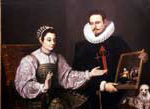VAM galleries including this work:
University of Kentucky Art Museum | What’s the Point? || VAM Home
Artist unknown (Spain)
A KNIGHT OF SANTIAGO AND HIS LADY, c. 1610
Oil on canvas; 43-3/8" X 56-5/8"
Purchase of Gaines Challenge Fund, 84.18
University of Kentucky Art Museum
While the name of the artist who created this painting is not known, details of costumes and style confirm that this double portrait was created in Spain in the early 17th century. The two figures, posing stiffly within a shallow space, are rendered in the tight brushwork and subdued colors that were typical of the period.
The painting is clearly the work of a master—a complex web of literal appearance and symbolic allusion. From their solemn mood to their dress and accompanying effects, the two individuals seem to be commemorating the joys and responsibilities of marriage. The dog, a well-known symbol of fidelity, and the small painting of Joseph and a pregnant Mary suggest that the sitters wished to be identified with the Holy Family and perhaps that the portrait was intended to announce the woman’s pregnancy. The piety of the sitters may be assumed from the presence of the religious painting and from the man’s tunic. It bears the “cross-and-sword” of the order of Santiago (St. James), which indicates he was a soldier in service to his country and the Church.
Classroom Ideas
Discussion: What is the focal point of this painting? Is the composition balanced? Why do you think the knight is holding a smaller painting? Discuss the idea of symbolism and possible meanings for various items in A Knight of Santiago and His Lady. Research the political and social climate in Spain during the 17th century and discuss how it is reflected in this painting. Compare it to family portraits from other eras.
Activity: Create a family portrait, including items of symbolic importance to your family and current times.
Links
For information about Spanish art and literature through the ages, see SpanishArts.com.
[www.spanisharts.com]
Another overview of Spanish art can be found at the ArtLex site.
[www.artlex.com/ArtLex/s/spanish.html]

